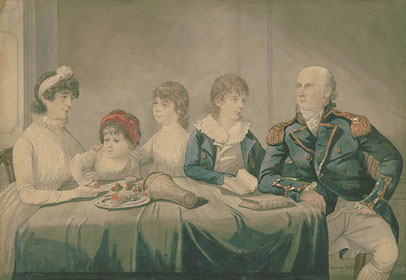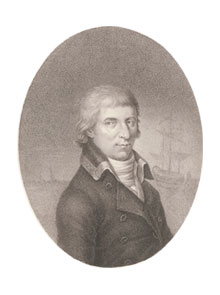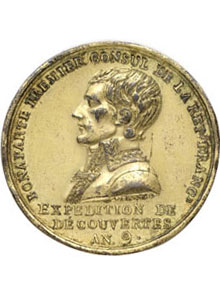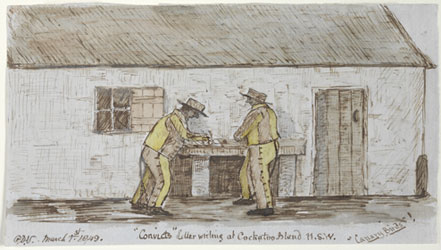Diplomatic relations: explorers, tourists and consuls
As a nation, the French have never been inclined to leave their homeland permanently. The turbulent political climate of late 18th and 19th century France, however, induced the migration of monarchists and republicans alike, all seeking adventure and advancement in the Australian colonies.
Although French place names remain along the coastline of the continent to mark the achievements of her mariners, France never claimed the areas of the Australia coast discovered by her navigators. While few French people have been associated with the exploration of inland Australia, they were perhaps among the country's first tourists.
Aide-de-camp: Francis Barrallier
Francis Barrallier (1773-1853) was one of the colony's earliest French settlers. Escaping to England with his parents when Napoleon took Toulon in 1793, Barrallier embarked on the Speedy to join the NSW Corps in November 1799, reaching Sydney in April 1800. His travelling companions included Philip Gidley King, returning with his family to assume governorship of the colony, and the two men struck up a friendship.
Philip Gidley King and Family, 1799, by Robert Dighton
Watercolour ML 1244
During his three years in the colony, Ensign Barrallier undertook various duties: he was aide-de-camp to the Governor, cartographer, engineer, architect, ship designer and explorer. In 1802, Governor King sent Barrallier on an 'embassy to the King of the Mountains'. The Great Dividing Range blocked expansion of the colony into the interior of the continent. Barrallier led two expeditions into the foothills of the Blue Mountains in an attempt to find a passage to the west but his party was soon forced to turn back.
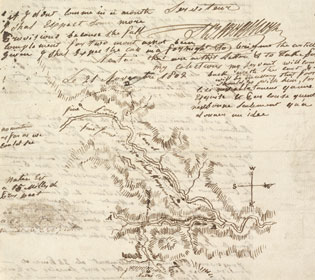
Detail from Letter with map to Governor King, 21 Nov 1802, by Francis Barrallier
Manuscript A1980-2/8, p.70
> Read the complete letter to Governor King from Francis Barrallier, 1802 ![]()
Barrallier also took an enlightened interest in the local Aboriginal people and he is believed to have first recorded the Aboriginal call 'coo-ee' which Pierre-Francois Bernier (1779-1803), astronomer to the Baudin expedition (1800-1804), set to musical notation. Leaving the colony in 1803, Barrallier continued a successful military career and died in England in 1853.
Explorers and tourists: Baudin, Freycinet and Pellion
Napoleon ordered the Baudin expedition, 1800-1804, to conduct a survey of the Australian coastline. Along the way, Nicolas Baudin (1754-1803) encountered Matthew Flinders (1774-1814) who was undertaking the same task for the British. The two expeditions met in April 1802, off the coast of Encounter Bay, South Australia, which Flinders' named to commemorate the event.
Above left: Detail from N. Baudin, c.1804, by Joseph Jauffret
Engraving P2/467
Above right: Commemorative medal for the Baudin expedition, 1800, by Pierre Montagny
Bronze gilt R 942
Francois Peron (1775-1810), the naturalist on the Baudin expedition, published an account of the journey, richly illustrated by artists and scientists, including reknowned natural history artist Charles Lesueur (1778-1846).
> View the plates from Voyage des decouvertes aux terres australes... (Atlas 1807) by Francois Peron ![]()
After Napoleon's final defeat in 1815, King Louis XVIII was restored to the French throne. Keen to raise the prestige of France, Louis de Freycinet (1779-1842) embarked on a scientific expedition around the world, 1817-1820. The Uranie arrived in Sydney in November 1819.
> Read letter from Louis de Freycinet to Barron Field, 1820, talking of his time in NSW ![]()
During the Freycinet expedition's six week stay, Governor Macquarie invited the party to undertake a guided tour of the Blue Mountains led by William Lawson, one of the three explorers who had blazed the original trail. Travelling along the new road to Bathurst, the French were among the first Europeans to see the interior of NSW. Jacques Arago (1790-1855) and Alphonse Pellion, the two expedition artists, took this opportunity to document the indigenous Australians they encountered along the way.
> See how sketches in the field were transformed into scientific art
Later scientific voyages were conducted by Louis Isadore Duperrey (1786-1865) and Jules Dumont D'Urville (1790-1842). Duperrey's voyage, 1822-1825, aboard Coquille was largely scientific with an emphasis on natural history, meteorology and magnetism. He had been previously been second lieutenant under Freycinet.
Durmont D'Urville, who was second in command on Duperrey's voyage, led his own expedition on the Astrolabe, 1826-1829. His objective was to investigate reported relics of the La Perouse expedition in the Pacific, as well as examining possible sites for a French penal settlement.
> View plates from Jules Dumont D'Urville, Voyage de la corvette l'Astrolabe... (Atlas historique) ![]()
Consuls and visitors: Delessert and Vigors
On 8 August 1839, King Louis Philippe signed a decree creating a French consulate in Sydney, convinced this town would become the major political and commercial centre of the Pacific. It was the first foreign consulate in Australia and the first French consul, Jean Antoine Marie Faramond, took up his post in May 1842.
Faramond flew the French flag from the roof of his Millers Point residence on the Sydney foreshore, giving indisputable visibility to French presence in the colony. Louis Sentis, who succeeded Faramond in 1852, moved the consulate to the 19th century French enclave of Hunters Hill.
> See how Sydney looked to a French artist in 1845
Eugene Delessert, sketcher and traveller, was born in France. He embarked on a world tour in 1844, reaching Sydney in December 1845. During his stay in NSW, Delessert was befriended by Consul Faramond and entertained by some of the colony's most prominent families. After his return to Paris in 1847, Delessert published two illustrated accounts of his travel experiences.
"Convicts" letter writing at Cockatoo Island, NSW, 1849, attributed to Phillipe de Vigors
Watercolour SSV/39
Little is known about the Frenchman who painted this rare picture of convicts writing letters at Sydney Harbour's Cockatoo Island. Subtitled "Canary Birds", it records a popular 19th century nickname for the prisoners, clothed in their yellow uniforms marked with a broad arrow. Signed 'P.D.V', Phillipe de Vigors has been suggested as the artist.
